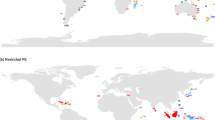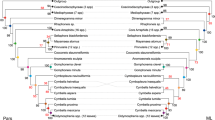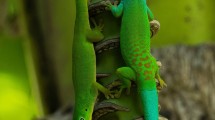Abstract
Arising from: V. Savolainen et al. Nature 441, 210–213 (2006); Savolainen et al reply.
Comparative studies of populations, particularly with the help of molecular markers, are necessary to understand the mechanisms of speciation in isolated oceanic archipelagos. Savolainen et al.1 present comparative data on two endemic species of the palm genus Howea in Lord Howe Island, from which they infer that speciation was sympatric — that is, divergence had occurred in the absence of geographic isolation. However, the landscape of oceanic islands changes dramatically over time, with many disappearing under the sea after 6 million years or more, and Lord Howe Island is in a very late stage of its ontogeny. An alternative explanation, therefore, is that these two species did not evolve in situ but instead that they arose allopatrically after becoming geographically isolated at a time when the island was much larger and more diverse ecologically.
Similar content being viewed by others
Main
Aside from well-known mechanisms of chromosomal polyploidy, examples of homoploid sympatric speciation in plants are rare. Savo-lainen et al.1 present interesting comparative morphological, geographical, ecological and molecular (AFLP, or amplified DNA-fragment length polymorphism) data regarding relationships between the two species of Howea palms endemic to Lord Howe Island. Considering that the distributions of the two taxa now overlap, the authors regard this as a good example of sympatric plant speciation. The difficulty with this interpretation is that it does not take into account island ontogeny and its possible impact on the two species. Sympatric speciation in islands, therefore, may still not have been convincingly demonstrated.
Lord Howe Island has a geomorphology that suggests strong erosion and surface loss, which correlates with its advanced age of 6.4–6.9 Myr. Dating from molecular sequences reveal the genus Howea to have diverged from progenitors 4.5–5.5 Myr ago, which is compatible with the island's age. By the same methods, the two species are judged to be 0.5–1.9 Myr old, at which time the island would still have been much larger than today. Loss of terrestrial area is more rapid during the later stages of island ontogeny, when the sea covers the last parts of the land.
Many other examples exist of sympatric and closely related plant species in oceanic islands. Such a pattern is evident among six species of Robinsonia (Asteraceae) from Masatierra Island in the Juan Fernandez archipelago in Chile2. My colleagues and I have estimated that this island, which is about 4 Myr old3, has lost up to 95% of its original surface area4. The pattern we now see can best be interpreted as refugial, with these species being packed together (sympatrically) in the remaining small surface area. The original mode of speciation would have been ecogeographical (allopatric).
An alternative hypothesis for the origin of the two endemic species of Howea on Lord Howe Island, therefore, is by allopatric speciation in different ecological (perhaps calcarenite) zones, when the island was much younger and much larger. The low degree of AFLP divergence between the two species of Howea does not necessarily argue for sympatric speciation. Island congeners typically show very little genetic divergence in DNA sequences and isozymes5. An absence of broad surveys prohibits generalizations at this point, but the limited AFLP data available indicate that very little divergence may have occurred between closely related species in islands that have speciated allopatrically6.
Before jumping to conclusions about sympatric speciation in oceanic islands, we need to exercise caution and factor in our best estimate of island geomorphic and habitat change, which together have had a major impact on genetic and species diversity7.
References
Savolainen, V. et al. Nature 441, 210–213 (2006).
Sanders, R. W., Stuessy, T. F., Marticorena, C. & Silva, O. M. Opera Bot. 92, 195–215 (1987).
Stuessy, T. F., Foland, K. A., Sutter, J. F., Sanders, R. W. & Silva, O. M. Science 225, 49–51 (1984).
Stuessy, T. F., Crawford, D. J., Marticorena, C. & Rodríguez, R. in Evolution and Speciation of Island Plants (eds Stuessy, T. F. & Ono, M.) 121–138 (Cambridge Univ. Press, 1998).
Crawford, D. J. & Stuessy, T. F. in Evolution and Diversification of Land Plants (eds Iwatsuki, K. & Raven, P. H.) 249–267 (Springer, Tokyo, 1997).
Parsons, Y. M. & Shaw, K. L. Mol. Ecol. 10, 1765–1772 (2001).
Stuessy, T. F., Greimler, J. & Dirnböck, T. Biol. Skrift. 55, 89–101 (2005).
Author information
Authors and Affiliations
Rights and permissions
About this article
Cite this article
Stuessy, T. Sympatric plant speciation in islands?. Nature 443, E12 (2006). https://doi.org/10.1038/nature05216
Published:
Issue Date:
DOI: https://doi.org/10.1038/nature05216
This article is cited by
-
Inverting the null-hypothesis of speciation: a marine snail perspective
Evolutionary Ecology (2009)
-
Sympatric plant speciation in islands? (Reply)
Nature (2006)
Comments
By submitting a comment you agree to abide by our Terms and Community Guidelines. If you find something abusive or that does not comply with our terms or guidelines please flag it as inappropriate.



